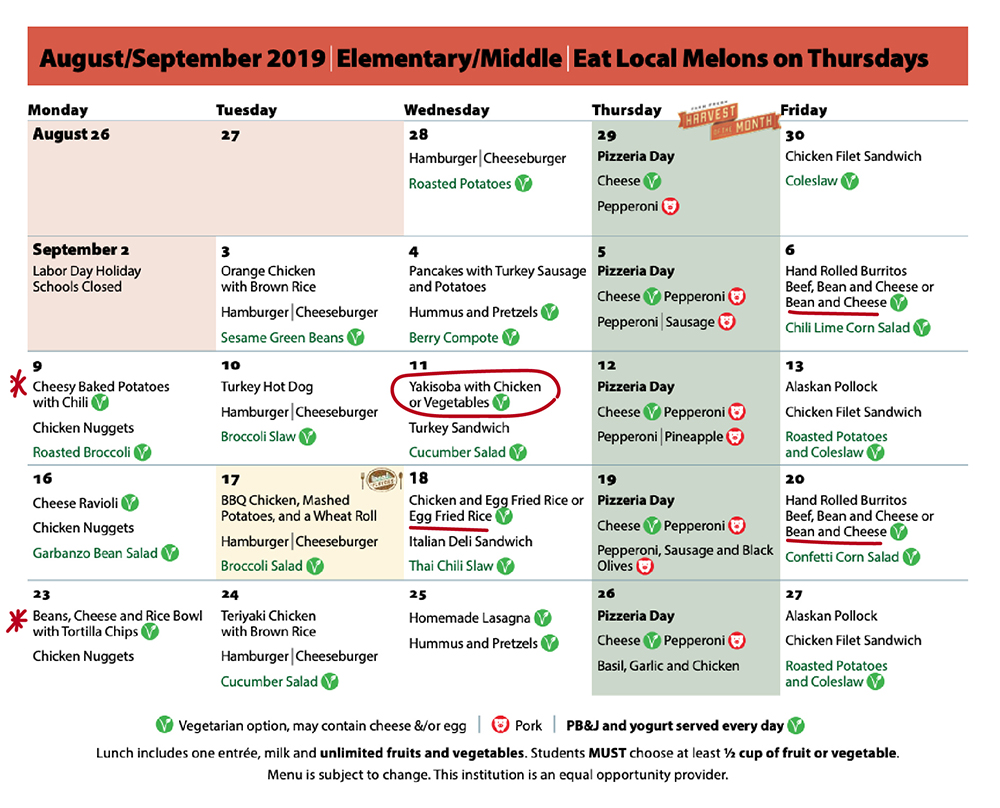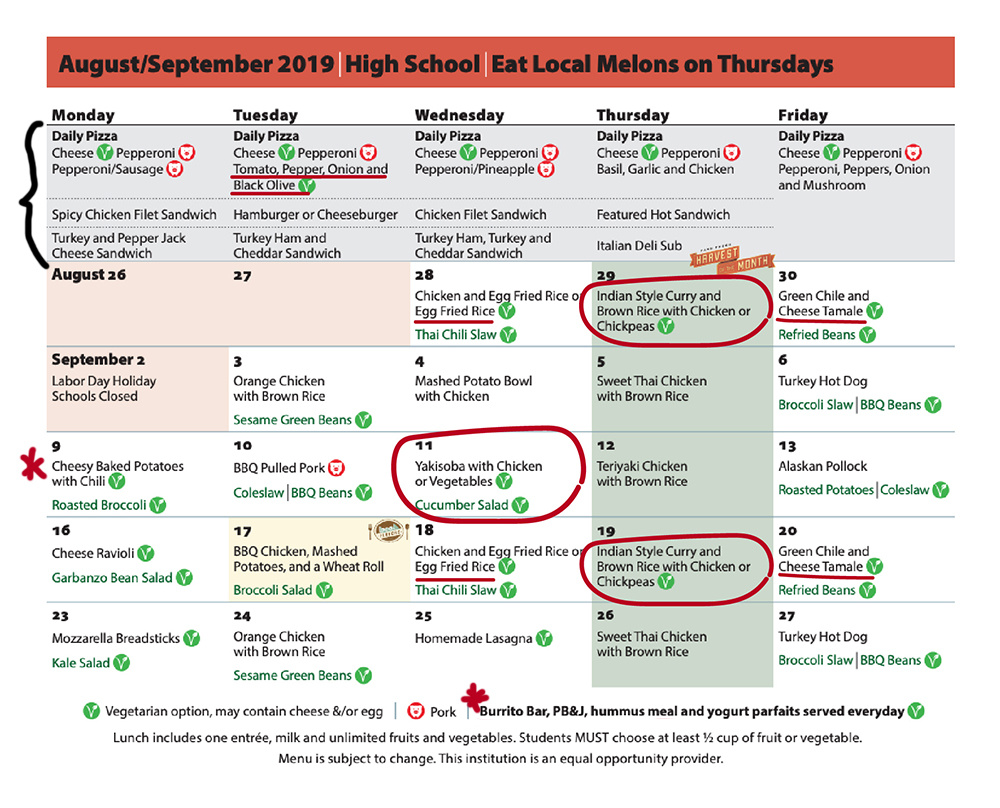We left off at the beginning of last summer with a small steering committee meeting from our group, and a meeting with Whitney Ellersick, Nutrition Director at PPS Nutrition. Originally, I had hoped to have some insight earlier to share with you as far as what the 2019-2020 school menu would look like, but I was not able to see it until right before school started on the website. House Bill 2579 passed which should allow more options with local food and school gardens. “The Bill, which increased farm to school activities support from $4.5 million to nearly $15 million will provide critical funds for Oregon schools to buy and serve Oregon foods, and districts and partner organizations to provide agriculture, nutrition, and garden-based educational activities.”
Good news also that tofu and now tempeh is credited as a protein with the USDA Food & Nutrition Services, giving us more options for plant-based meals.
Whitney gave us this great update for the 2019-2020 school menus:
“On our elementary menu, we were able to make all of our featured entrees on Monday vegetarian and/or vegan. We took many of our entrees and made them flexible choices – such as when we menued burritos, instead of having just beef or bean menued, we have both. We have many entrées like this on Wednesdays – such as our fried rice we are making with chicken or no chicken (egg only), yakisoba (with chicken or veggie), taco salad with beef or beans, and curry with chicken or chickpeas. While I know these entrees may not have plant-based proteins, specifically, it does increase our options for vegetarian entrees and puts us in a better position to either add a plant-based protein like tempeh or tofu once we have sourced it and tested it, or for students to request “no cheese” on some of our options that do make it vegan as opposed to vegetarian.
On our high school menu, we have added the shaker salads which once I’ve finalized some other recipes will be promoting as “power bowls” that will be vegan/plant-based protein options.
These will be daily options on our high school menu. In addition to the elementary choices that I mentioned above, we also will be adding the Ethiopian simmer sauce to our menu regularly. We are working on sourcing lentils since last year we struggled to get them into our warehouse. My hope is to offer this dish with lentils regularly once we have them more readily available.
As always, our taqueria/burrito bar line is offered at high schools where students can customize their options whether they would like it vegan, vegetarian, gluten-free, etc.
We are continuing to expand our sourcing and hope to have more for this year.”
This is progress and we are happy to have this moving towards more flexible options, definitely. And while it looks good to see a lot of green V’s on the menu, we are not there yet with our goals, especially with K-8, and also with the default options. See the top of the high school menu, what if one of those options could change to plant-based? For K-8, their only option is the Smucker’s PB&J.

My own children are both in high school and are vegetarian. They take school lunch every day. Most days when I ask what they ate, the answer is “nachos” or “cheese pizza”. Only on the days when the Indian chickpea curry or new entrée is served, do I feel like they had something healthy.

The goal of this initiative is not to cater to vegetarian and vegan students, but to give all students healthy, delicious plant-based options to decrease our city’s carbon emissions. This is critical as we work towards climate solutions that we move away from meat. As we have seen this summer, the world’s demand for beef has increased the amount of deforestation in the Amazon used for animal feed crops and grazing. While we can’t change the world, we can change our part of it.
What are our next steps?
Raise Awareness.
We’ve been invited to have a booth at NW Veg’s annual Veg Fest. This event draws over 8,000 people and most are the general public who are interested in vegan options and tasting the wide array of samples available. Children under 12 can attend for free, so it usually draws a lot of families. Our partners FFAC and the Raven Corps will also have booths at the event. This will be a great informational opportunity for us to share what we are working on and expand our group. We are looking for volunteers for either of the days October 5 or 6th! 10–6 Saturday, 11–6 Sunday at the Oregon Convention Center, Hall A-A1. Please email me, amy@eat4thefuture.com
Education is key.
The more parents and students understand the link between our food and the climate crisis, the more support we will have. We don’t have a lot of time- around 11 years to move to dramatically lower emissions, although that may be an optimistic time frame. The students that are starting kindergarten will only be freshman or sophomores in high school before our carbon path is locked in. We need to change the trajectory NOW if we want to give them a chance for a livable future. Sadly, this is not an exaggeration, and it is why we are seeing global strikes and youth are taking action. You can help make this link clear to parents and students by inviting our partner, Factory Farming Awareness Coalition to give a Green Monday presentations in your school classroom or PTA. Contact them for more information.
Student involvement
Eco-School Network is a great resource for elementary and middle school parents and students to work with school green teams and also to network our school sustainability efforts.
Students 14-18 can join efforts with The Raven Corps, a local nonprofit youth organization that promotes environmental sustainability, compassion, and community through a plant-based advocacy.
We have some thoughts on student involvement, and we would like to meet up with students and get their ideas. We’ll be sending an invitation out soon for that meeting.
Parent involvement
Sampling: We have been told this is critical to adding new items. We will keep checking in with Whitney to find out when and how we can help with this.
Recipe ideas: We haven’t been specifically asked to provide recipes, but showing Whitney the foods that students enjoy most at home can be helpful, and then adapted to meet the requirements schools face.
Support Greener World Days and ask for what you need.
Many students we surveyed and talked to have simply given up on buying school lunch since they are non-dairy, vegan or wanted different choices. Please support the plant-based shift by buying lunch on the days the chickpea curry, vegetable yakisoba, and others are served. This will help lead to more of these options. Also, the cafeteria staff has indicated that they are willing to serve special items for those avoiding meat and dairy. Ask for the soy milk and that will increase demand. If more students are asking specifically for plant-based items it creates a noticeable impact.
Thank you for any feedback you have. Now that we are all back to a more structured time of year, we will continue to work together! Hope to see many of you at the Global Climate Strike, September 20 at 10:30 am Portland City Hall. Look for the Raven Corps and other climate groups there!

